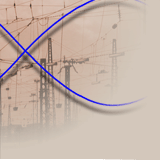| |
|
Osmose
is a Virtual Reality installation currently touring the UK as part of
the 'Serious Games' exhibition, and is a ground-breaking use of the technology
in fine art. I am probably both the best and the worst person to review
Osmose, for the following reasons. I am instinctively sympathetic
to the piece because I share so many of the interests of the creator,
but unfortunately this also makes me more critical than the average participant.
Char Davies, its creator, is a painter who happens to be the Director
of Visual Research at SoftImage. This is the Montreal-based producer of
the computer animation system of the same name, recently bought out by
Microsoft. Her aims in the creation of Osmose all strike chords
with me: she wants to reproduce some of the qualities of mystical experiences
of Nature in a VR piece; she wants to create an experience not of doing
as prevalent in combat games using the same technology, but of being.
Osmose is intended to be reflective, gentle, immersive - qualities
that relate to Char's experiences of Nature -, and anchoring in bodily
experience. In her own notes on Osmose [1] she discusses an experience while scuba-diving
which was mystical, and in a recent interview for a British TV programme
on cyberspace she mentions a mystical experience that she underwent in
a field. I understand that these have been instrumental both in her work
as painter, and in the development of Osmose. As I have been researching
the subject of Nature Mysticism for some years I welcome any attempt to
use cyberspace technologies to introduce this subject to new audiences.
I am also sympathetic to her desire to redress our culture's privileging
of mind over matter which (in her own words) 'has contributed to the devaluing
of the body, as well as women and various "others"'.
I believe that Nature Mysticism is important for two reasons: firstly
it is a spirituality appropriate to a secular age, and secondly, by emphasising
a love of Nature, it can underpin the growing ecological awareness needed
for our survival. It is in this context that I am interested in Osmose.
What is Osmose however? It is a virtual reality installation using
a head-mounted display (HMD) and a chest-mounted sensor for measuring
the breathing. A Silicon Graphics Onyx provides a real-time 3D rendered
view of a virtual world consisting of a dozen 'levels', and an audio sub-system
generates a sound track which will be unique to each participant's journey.
My only previous experience of HMD-type VR is with the Sega 'Space Mission'
ride at SegaWorld in London. Osmose differed in its input device
however; no buttons or joysticks, but a custom-made chest-mounted device
for responding to the user's breathing. Once this is adjusted by the assistant
one is ready for 'immersion'. The image quality of Osmose is significantly
better than with the Sega ride, though still quite low resolution and
a little faint. (SGI's 'RealityMonster' graphics supercomputer offering
80 million polygons per second would offer near photo-realistic VR, in
comparison, and may be the shape of things to come.) Osmose opens
with an initial set of 3D grids (used to establish the basic navigation
techniques) which are enticing in themselves as a definition of a space
to be explored, and were effectively depth-cued to add to the sense of
distance.
As the grids faded away one is left to expand or contract one's chest
in order to descend or ascend the virtual world. Leaning forward, backward,
or to either side moves one in those directions, and turning one's whole
body around enables one to gain a 360 degree panoramic survey of the space.
The virtual world of Osmose is a stratified universe where the
word is both at its foundations and at is apex; the levels inbetween
represent a version of nature. The lowest level (reached only after emptying
the lungs for a period) consists of planes covered with the text of the
source code for Osmose (recognisably C code), while the highest level
is again textual, but this time containing quotes from poets and philosophers
in many languages. The metaphor is clear: the word as code or DNA
is the foundation of our physical existence, while the word of
our greatest thinkers represents the peak of our experience.
In practice one is not enticed to spend long in either of the textual
levels: it is the representations of nature in the middle worlds that
make Osmose so powerful. A tree is the centrepiece of this layer, and
around the tree is a 'landscape' comprising a river and forest. The elements
of this world are all semi-transparent, and by approaching a leaf one
can enter its cellular level and see the transport of shimmering nutrients.
The general reaction of Osmose participants is highly favourable, and
couched in terms ranging from pleasure to awe. The television cyberspace
documentary mentioned above showed several participants who were clearly
deeply affected, and the visitors' books in Montreal and Newcastle are
full of simple responses like Brilliant, Wow!, Magic!, and also more considered
statements including:
Blimey!
I think I'll go and write a book about this.
This is
really brilliant, very innovative, very enjoyable very shocking, very
relaxing - well done the Laing [Gallery].
A Chance
Encounter Which Shan't Be Forgotten.
Amazing!
finally V.R. as good art! I'm looking forward your [sic] next work!
Out of ten
favourable comments like this there might have been one negative one,
for example one person commented that there was not enough colour in the
work; another thought it should be made more interesting for children.
Most reviewers within the electronic arts have also been favourable, with
the exception of the team from Mute, the London-based broadsheet
of digital art critique [2]. The
basis of their objection seemed to be firstly a hostility to the goals
set by Davies (dismissing them as a kind of human-potential psycho-babble),
and secondly to the sheer cost of producing the installation. It is true
that the original Silicon Graphics machine used to run it could cost up
to CDN$ 1m (depending on configuration), and that on current prices this
has fallen to only about a quarter of this figure, but there are VR-capable
systems evolving from the bottom up on PC and Mac platforms that will
soon give access to this medium for the majority of electronic artists.
The sarcastic boxed quote in the Mute article: 'I wonder at the
brilliant interpretative insight of this artist to make the leaf green!'
gives an idea of the general tone of the article.
As an honest reviewer I have to say that I was however less impressed
with the experience than most participants. I think the reason for this
is that, as a person who has an active interest in nature mysticism and
has carried out extensive research into the subject, the natural world
in Osmose is too literal. True, some of it looks fairly
abstract, but some of it is a direct quote: scanned images of leaves have
been texture mapped onto flapping polygons, for example. For me then,
this is the main weakness of the piece: the spiritual in 20th century
art has been inextricably linked with the development of abstraction (a
thesis put forward by the art historian Roger Lipsey [3]
for example), yet Osmose uses a literalness more appropriate to the 19th
century.
But Char Davies might be right. One of the world's greatest nature mystics,
Walt Whitman, had this to say about the general approach to nature:
"All
such things need to be at least the third or fourth remove; in itself
it would be too much for nine out of ten readers. Very few care for
natural objects themselves, rocks, rain, hail, wild animals, tangled
forests, weeds, mud, common Nature. They want her in a shape fit for
reading about in a rocking-chair, or as ornaments in china, marble or
bronze. The real things are, far more than they would own, disgusting,
revolting to them." [4]
To Whitman's
list of china, marble and bronze we can now add VR; it certainly is nature
at third or fourth remove. For me Osmose is 'ornamental' in Whitman's
sense, but for the majority of participants it clearly works. Henry Thoreau
(a contemporary of Whitman) may have a point when he wrote:
"I
walk towards one of our ponds, but what signifies the beauty of Nature
when men are base? We walk to lakes to see our serenity reflected in
them; when we are not serene, we go not to them." [5]
Although
the Victorian use of the word 'base' may obscure his meaning to us, I
think that Thoreau's point is this: if you are already attuned to Nature
you see its beauty, and are drawn to it; if you are not attuned to it
its beauty will not draw you to it. What then can break into this vicious
cycle? Answer: Osmose, or any work of art or literature that reflects
on Nature. The fact that it is too literal for me may be because I 'care
for natural objects themselves' as Whitman puts it.
Another of my interests leads me to make another criticism of Osmose:
the relation to breathing. While I know nothing of diving, I have studied
the Indian system of pranayama, breath-control. Davies is quite
right in placing an emphasis on breathing in the context of shift from
doing to being; it said that the Buddha, for example, attained enlightenment
through the practice of breath-awareness (loosely called vipassana).
However the Indian system places an emphasis on the depth and regularity
of breathing (and, interestingly on the turning points between in- and
out-breath), but the system used by Osmose forces one to breath
shallowly, either with the lungs relatively empty (in order to descend)
or relatively full (in order to ascend). Davies' goal is only half-met:
to bring about a change in a person's psyche, the soma (body) needs to
breathe fully. Bringing a person's attention to the breathing in
any form is however valuable, and I don't doubt that this device does
contribute to the overall experience.
However Osmose is clearly a watershed in the evolution of VR as
an artistic medium, and anyone attempting something similar will have
to acknowledge this. To carp at it because the sheer cost prevents wider
participation is absurd: costs are tumbling exponentially, and similar
though cruder results can be achieved with affordable equipment,
even now. My personal objection to its literalness is probably at the
heart of the artistic problem with VR: three-dimensional space is so fundamental
to the structure of our universe and to our experience of it that we don't
yet know how to play with it in VR. My instinct is that the painter
may be in the best position to do this, but needs to revisit the birth
of abstraction in the early part of this century for clues.
References
[1]
Davies, Char, Osmose: Notes on Being in Immersive Virtual Space,
ISEA'95 Proceedings, Montreal 1995, p. 53
[2] Mute DIGITALARTCRITIQUE,
Issue 3 Autumn 1995
[3] Lipsey, Roger, An Art of
Our Own - The Spiritual in Twentieth-Century Art, Boston and Shaftesbury:
Shambhala, 1988
[4] Bucke, R.M. Walt Whitman,
Philadelphia, 1883, p. 61
[5] Thoreau, Henry, Walden
and Other Writings, Bantam, 1962, p. 16
|
|



